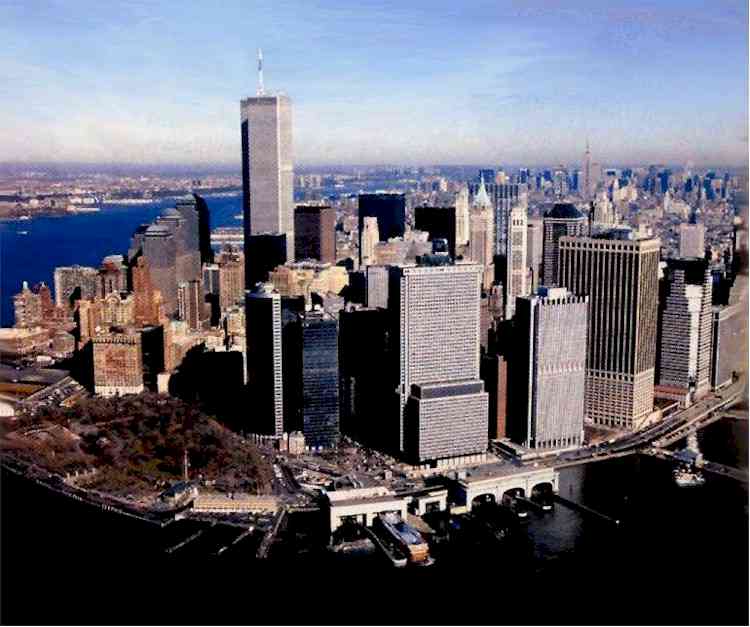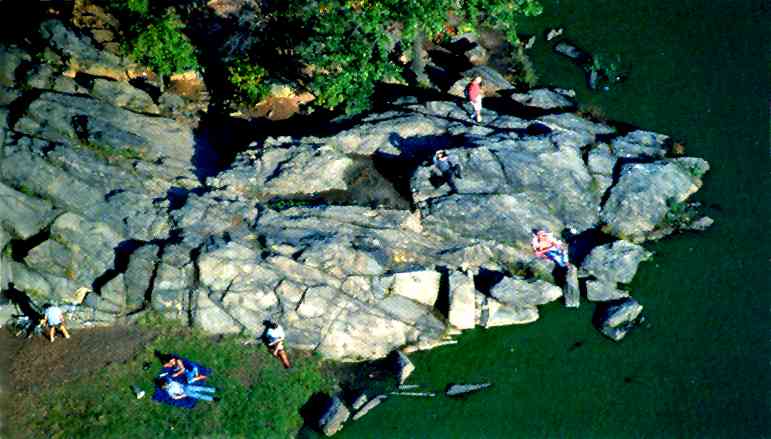Blaming Gaia
Seeing the Earth for Its FaultsThe present in New York is so powerful that the past is lost. - John Jay Chapman New York is the perfect model of a city, not the model of a perfect city. - Lewis Mumford
New York Skyline owes everything to geology. The financial district and Midtown support towering buildings because bedrock is no more than 38 to 80 feet below the surface. In Greenwich Village, however, it is about 260 feet down. The following article was, of course, published before the events of 11 September. I considered editing out the World Trade Center buildings but decided against it. The caption is ironic - maybe not everything about the New York skyline is owed to geology - now... by Marguerite Holloway Geological tours and guides expose the secrets of New York City and beyond Continents collided - northwestern Africa crashed and ground against North America - and mountains as tall as the Alps rose in New England. Wind and rain beat at the peaks and wore them down, and then the land on which they stood sank below the sea. Waves and tides had their turn, and the towering ranges were largely leveled. The land lifted. The balmy weather turned cold. Ice sheets scraped across bedrock, pushing a wall of rubble before them. The climate warmed again, and glaciers melted, creating a huge lake that lapped behind the wall of glacial till. Ice sheets kept melting; the lake swelled and stretched and, ultimately, broke through the wall at its lowest part. Rivers began to flow through valleys that the glaciers had carved. Before politics, culture and high finance, these were the forces that shaped New York City. To see New York thus is to see it with the eyes of a geologist, to see the sweep of millions of years, and to understand why certain things look the way they do and stand where they do. The scar where continents ground together runs down the Bronx River; the remnant of the mountains is the city's bedrock; the rubble pushed by the glaciers gave rise to Long Island; the great lake spilled over at the Verrazano Narrows; the Hudson and East rivers fill valleys deepened by glaciers. Wall Street and Midtown raised modern mountains of glass and granite because there was solid bedrock to build on, but in between lay insufficient foundation for skyscrapers - hence low-slung Greenwich Village and Soho. Before garbage and landfill were strewn in its wetlands, Manhattan was cut in two when very high tides swelled the rivers and they met each other in the middle of the island, at 125th Street, where a fault slices the city. All this insight and more can come from a three-hour cruise up the Hudson River - or the East River or through New York Harbor - with Sidney Horenstein of the American Museum of Natural History. "Since geology is the basis of everything, you just cannot help, once you get involved in this, to go beyond the geology," says Horenstein, author of the Audubon Society's guide to Familiar Fossils of North America and coordinator of environmental programs at the museum. "Because if you look at the landscape, you can't help saying, 'What is that?' and 'How did this happen?'" Horenstein's Circle Line trips, which for about a decade have taken place in early summer, are as renowned for his observations about geology as they are for his historical anecdotes, questionable puns ("The reason all the lights are lit up here is that we are approaching the Battery") and sayings. On a recent sunset cruise packed with passengers and their picnics, Horenstein explains his answer to the controversial question of how the Big Apple got its name: from a bordello owner named Eve and the "apples" who worked for her. He describes how 300-million-year-old invertebrate fossils ended up in the walls of Riverside Church's bell tower: the sandstone was brought in from Indiana, site of an ancient tropical sea. And a discussion about New York's main rock formations gives Horenstein a chance to quote a favourite refrain: "The Bronx is gneiss, but Manhattan is full of schist. Inwood has lost its marbles, and New York is full of faults." During other parts of the year, Horenstein gives talks and leads regional geological field trips. "Boats are just one aspect of it," Horenstein says. "I lead tours all over, just like a gypsy cab." One, for example, is a walking tour of Central Park, where participants can see the scratches carved in schist by roving glaciers and some of the boulders left behind by melting ice. Another lecture series covers geology and travel: how to recognise geologic features wherever you find yourself. (For information about scheduling, check the American Museum of Natural History's Web site at www.amnh.org or call the main reservations line at 212-769-5200.)
Glacial Movements left marks on rocks that can be seen in Central Park. Many other paths also wander into New York's geologic past. Charles Merguerian of Hofstra University, author with John E Sanders of myriad papers on the region's geology, has designed virtual field trips of the city and environs, which can be viewed or ordered at www.dukelabs.com. The Parks Department organises some excursions as well. And the South Street Seaport Museum's off-site permanent exhibit "New York Unearthed" provides a window into the city's archaeology. For those who want to explore the rocks and faults alone, there is a general site for New York (albany.net/~go/newyorker/index.html), with references and materials, as well as several good books, including John Kieran's A Natural History of New York City and Wild New York, by Margaret Mittelbach and Michael Crewdson. If you prefer instead to conjure the creatures that lumbered through the landscape - to envision the ground sloths, hairy tapirs, saber-toothed tigers, woolly mammoths and mastodons that were the region's wildlife during the Pleistocene - you can find fossil hunters to follow. The New York Paleontological Society, which Horenstein founded in 1970, has monthly meetings most of the year and organises field trips to look for fossils. One such tour this summer took members to Hamburg, NY, to observe Devonian fossils, such as trilobites, in a quarry. Another tour entailed visiting fossil trackways in Connecticut's Dinosaur State Park. (Go to nyps.org.) But no matter which city or state or region or country you are in - or whether you have easy access to a natural history or related museum - you are free to see with a geologist's eyes. Many states have a paleontological society, and although you might have to join to be able to participate in the field trips, membership is typically only about $20 for a family. A number of states also have a mineral society that leads tours - often these societies are members of the American Federation of Mineralogical Societies (amfed.org) - as well as a survey that details the geology of the region. The Utah Geological Survey, for instance, provides local information on dinosaur fossils. In addition, Horenstein and other experts recommend a helpful series of books. Published by Mountain Press in Missoula, Montana, the Roadside Geology books are written by geologists for laypeople (see mountainpresspublish.com). Almost half the 50 states have a guide, from Roadside Geology of Alaska to Roadside Geology of Wyoming. The press also publishes books on various regions of the US, several national parks and a few countries, including Canada and Argentina. To see familiar places against the backdrop of aeons is truly a grand view, both humbling and haunting; in the rise and fall of the land in your mind's eye, you can see the earth breathe. Source: Scientific American September 2001 sciam.com; photo credits: NY skyline by Guido Alberto Rossi for The Images Bank; Central Park by Yann Arthus-Bertrand for Corbis
For articles on bacteria, centrioles, chairs, nebulae, asteroids, robots, memory, chirality, pain, fractals, DNA, geology, strange facts, extra dimensions, spare parts,
discoveries, ageing and more click the "Up" button below to take you to the Table of Contents for this Science section. |
 Animals
Animals Animation
Animation Art of Playing Cards
Art of Playing Cards Drugs
Drugs Education
Education Environment
Environment Flying
Flying History
History Humour
Humour Immigration
Immigration Info/Tech
Info/Tech Intellectual/Entertaining
Intellectual/Entertaining Lifestyles
Lifestyles Men
Men Money/Politics/Law
Money/Politics/Law New Jersey
New Jersey Odds and Oddities
Odds and Oddities Older & Under
Older & Under Photography
Photography Prisons
Prisons Relationships
Relationships Science
Science Social/Cultural
Social/Cultural Terrorism
Terrorism Wellington
Wellington Working
Working Zero Return Investment
Zero Return Investment
